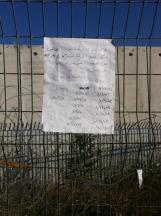Container (Wadi Nar), Ras Abu Sbitan (Olive Terminal), Silwan
6:40 Abu Tor Street
We had heard but couldn't believe until we saw with our own eyes that the checkpoint regime had reached the mixed neighbourhood of west Jerusalem. Concrete blocks obstruct passage on the road from Abu Tor Street in the direction of the school. A fortified and manned jeep stands and invigilates across the road near the beigel seller. When we arrive, the soldiers outside are counting their ammunition, then disappear into their jeep. There are no inspections of pedestrians.

The residents tell that the checkpoint has been there since the turbulence following the attack on Yehuda Glick and the shooting of the Palestinian terrorist in his home down the road. Some say that stones are hurled nightly at the checkpoint, and others that things have been calm for several days. The blocked road means that children cannot be taken to school, or the handicapped living on the street driven to their destinations, or indeed generally the Arab population of Abu Tor cannot drive into or return from west Jerusalem unless they take a large detour through north-eastern Silwan.
A delegation has approached the mayor, asking to remove the checkpoint which constitutes collective punishment for the old mixed neighbourhood in Jerusalem, but the mayor was not interested... We spoke with residents -- men, women and children -- who all expressed despair and humiliation, and asked: How long?!
8:00 Silwan and Wadi Joz
We left the neighbourhood through Gai Ben Hinom and drove to Olive Terminal through Silwan and Wadi Joz. Everything looked remarkably calm -- perhaps due to yesterday's attacks and the fear of Israeli retaliation in east Jerusalem in their wake. Border police jeeps can be seen here and there but there are no checkpoints at the entry to Silwan or Wadi Joz, and traffic flows with reasonable ease. The city appears perfectly normal, no sign of the third intifada which the media advertise.
8:10 Olive Terminal
Few crossing at the checkpoint. Soldiers and transportation personnel report of sparse passage of workers this morning: 300-400 as opposed to the regular 2000-2500. A woman with a baby carriage tries in vain to catch the eye of a female soldier who should open the humanitarian gate for her -- only after our intervention does the soldier lift her eyes from her phone and opens the gate.
carriage tries in vain to catch the eye of a female soldier who should open the humanitarian gate for her -- only after our intervention does the soldier lift her eyes from her phone and opens the gate.
Our eyes catch a notice in Arabic (see photo) stuck on the checkpoint fence, and the transportation people tell us that this is an expropriation order of areas surrounding the checkpoint (in the direction of Al Ezariya), and the hills between Al Ezariya and Ma'aleh Adumim (i.e. the southern part of E1). Such notices have appeared in several locations. Our efforts to find out more from the Jerusalem Envelope DCO turn up nothing. We try to reach the journalist Nir Hason, without success. We ask Hanna Bar"ag to check if these expropriations are in anticipation of paving a road exclusively for Palestinians from Al Ezariya to Olive Terminal (but only for those who have Jerusalem residence ID's -- the rest are not allowed to cross). Hanna will ask "Yesh Din" investigators to check, and then we will report.

8:40 Wadi Nar
The way to the checkpoint has undergone a remarkable upgrade: security fences on the steep and winding road from the Al Ezariya wadi have been installed, and everything is newly paved. An impressive roundabout had been constructed above the checkpoint -- everything secure and user-friendly, courtesy of US AID, and Palestinian Authority labour. Innovations at the checkpoint are in progress. There were no inspections of vehicles during our stay, and no traffic delays. There's a new generation of dogs and a cute, shy donkey. The grocery shop has become a small mini-market.
On the one-way road back to Al Ezariya solar lighting has been installed. The little neighbourhood is entering the 21st century.
